Posts Tagged ‘history’
-
AN UNEXPECTED VISIT
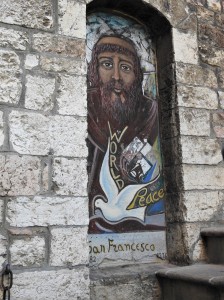 Francis Bernardone came upon the abandoned church of San Damiano in Assisi by accident. He was searching for a place to meditate to find a way forward for his life, when he entered the church and saw a crucifix. As he prayed earnestly in front of it, he heard a voice telling him, “Francis, go and repair my church which, as you see, is all in ruins!” This brief moment changed not only the man’s life but even his birthplace, the Catholic Church, and the lives of many others. An unexpected visit to Assisi proved that the timeless appeal of this instant still prevails.
Francis Bernardone came upon the abandoned church of San Damiano in Assisi by accident. He was searching for a place to meditate to find a way forward for his life, when he entered the church and saw a crucifix. As he prayed earnestly in front of it, he heard a voice telling him, “Francis, go and repair my church which, as you see, is all in ruins!” This brief moment changed not only the man’s life but even his birthplace, the Catholic Church, and the lives of many others. An unexpected visit to Assisi proved that the timeless appeal of this instant still prevails.Dropping by at Assisi for a few hours while exploring the surrounding towns, I found myself getting absorbed in the spiritual atmosphere of this medieval location which has earned its place in the UNESCO list of World Heritage Sites for its influence on religious expression and Europe’s art history. Although it was anticipated that I would visit some churches, I was blown away by the monumental beauty of the basilicas, the medieval character of the town, the intriguing archaeological structures and the boundless feeling of serenity.
The Papal Basilica of St Francis of Assisi dominates the town. It constitutes two churches which are known as the lower and the upper churches. Whereas the lower church is austere and sombre, symbolising the humanity and humility of the saint, the upper church is high vaulted, airy, and widely illuminated to resemble his sanctity and glory. The arcades that line the open square as you approach the basilica were originally used to shelter and feed medieval pilgrims. Nowadays, these offer refuge from the natural elements to the numerous visitors who come to Assisi.
 According to legend, the area on which this basilica was built was originally considered disgraceful since it was a place for public execution. Francis chose it as his burial place because he considered himself as the worst sinner. Today, this blessed location which holds within it the venerated remains of the saint is renowned as the ‘Hill of Paradise’.
According to legend, the area on which this basilica was built was originally considered disgraceful since it was a place for public execution. Francis chose it as his burial place because he considered himself as the worst sinner. Today, this blessed location which holds within it the venerated remains of the saint is renowned as the ‘Hill of Paradise’.The interior of the basilica is an awesome masterpiece which bursts into your senses. Never have I seen such colourful splendour which reaches from top to bottom with frescoes done by leading artists of the 13th century, such as Cimabue, Giotto, Simone Martini, and Pietro Lorenzetti. In contrast, the cruciform crypt of St Francis located deep beneath the two-levelled basilica, is raw and simple. A large open pillar contains the roughly hewn stone sarcophagus which holds the blessed remains of the saint. In the four niches positioned at each angle facing the tomb lie the four disciples of St Francis: fra Leone, fra Masseo, fra Rufino and fra Angelo.
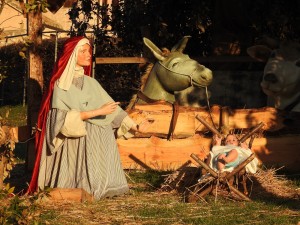 Even though Christmas celebrations were long over, the Christmas spirit was still very present in Assisi. An exhibition of traditional cribs animated the silent corridors of the friary which is built adjacent to the basilica. Likewise, a large crib with numerous life-size figures gave life to the wide-open area in front of the upper church.
Even though Christmas celebrations were long over, the Christmas spirit was still very present in Assisi. An exhibition of traditional cribs animated the silent corridors of the friary which is built adjacent to the basilica. Likewise, a large crib with numerous life-size figures gave life to the wide-open area in front of the upper church.The main street named after St Francis leads from the basilica to the centre of the town. Like any pilgrimage site, Assisi has become highly commercialized, flooded with souvenir shops which sell all types and all sizes of mementos that depict the saint. Various hotels offer hospitality to the pilgrims and visitors who opt to relish this medieval town’s atmosphere for longer. The elegantly restored 13th century Santa Caterina Monastery, now known as Nun Assisi Relais & Spa Museum, has been turned into a minimalist-styled hotel, and is an unparalleled destination.
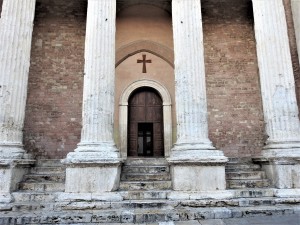 The main square, Piazza del Comune, was always an important point in the town. This is evident by the presence of a Roman temple which is the focal point of the square. Built in the 1st century BC, the imposing temple was originally attributed to the goddess Minerva due to the finding of a female statue. However, recent archaeological discoveries in the area pertaining to other gods have created doubts about which god was honoured by this stately structure. The façade of the temple, with its six huge Corinthian columns supporting the architrave and a small pediment, has now been preserved. The pagan building which is also a UNESCO World Heritage Site serves as a bizarre entrance to the church which it now houses, Santa Maria sopra Minerva.
The main square, Piazza del Comune, was always an important point in the town. This is evident by the presence of a Roman temple which is the focal point of the square. Built in the 1st century BC, the imposing temple was originally attributed to the goddess Minerva due to the finding of a female statue. However, recent archaeological discoveries in the area pertaining to other gods have created doubts about which god was honoured by this stately structure. The façade of the temple, with its six huge Corinthian columns supporting the architrave and a small pediment, has now been preserved. The pagan building which is also a UNESCO World Heritage Site serves as a bizarre entrance to the church which it now houses, Santa Maria sopra Minerva.References to St Francis are present wherever you go in Assisi. Niches, wall paintings, and statues of his parents Pietro di Bernardone and Madonna Pica, continually remind you that this is the birthplace of the saint. Nevertheless, the curious visitor can still encounter offbeat locations such as art galleries, tartufo shops, and traditional cuisine.
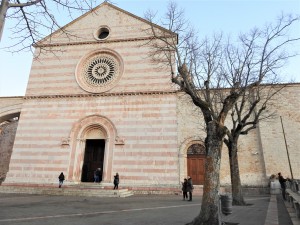 My visit ended at the Basilica of St Clare. Interestingly, the structure of its façade strongly imitates the upper church of the Basilica of St Francis, just how St Clare followed St Francis. Although far from the exuberant quality which one finds in the Basilica of St Francis, this church is still beautifully adorned. The ceiling of the chamber which houses the tomb of St Clare is pleasantly decorated with a blue sky filled with shining stars.
My visit ended at the Basilica of St Clare. Interestingly, the structure of its façade strongly imitates the upper church of the Basilica of St Francis, just how St Clare followed St Francis. Although far from the exuberant quality which one finds in the Basilica of St Francis, this church is still beautifully adorned. The ceiling of the chamber which houses the tomb of St Clare is pleasantly decorated with a blue sky filled with shining stars.The humbler nature of this basilica does not diminish its respect or importance. The Crucifix Chapel located inside protects within it the Byzantine cross which was originally at the ruined church of San Damiano. On the other hand, the Chapel of the Blessed Sacrament occupies the area of the ancient Church of St George, in which both St Francis and St Clare were buried until their basilicas were constructed.
A splendid sunset welcomed me as I stepped out in the square of the Basilica of St Clare from where I could enjoy a fantastic view of the surrounding area. Rocca Maggiore castle hovered over the town and bid me to visit, while at a distance, the Renaissance Basilica of St Mary of the Angels which houses the Porziuncola, the most sacred place for the Franciscans, reminded me that there was so much more to discover.
(This feature was published in the SENIOR TIMES issued with The Times of Malta dated 15th February 2019)
-
MINIATURE CHURCH DEVOTION
As several bombs were let loose on our islands during the attacks of World War II, their destructive effects threatened more than human lives and buildings. They put at peril our heritage, jeopardizing the roots of our people and the future of our country.
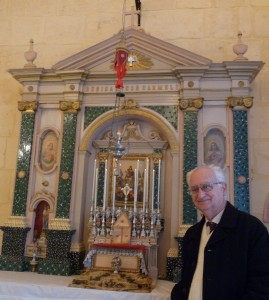 Raphael Micallef, now 82, still recalls the terror felt by the people as the shrill of the air-raid sirens urged them to leave their houses and run for shelters. As an inhabitant of the capital city, he saw his town being shattered to pieces, the damage claiming even unique treasures such as the Chapel of Bones which used to be so popular both with the locals and the tourists. People huddled together in shelters and prayed for their own safety but they also implored for their houses to be spared as these nested within them all their possessions, memories of loved ones, and valuable objects which had been passed on from generation to generation.
Raphael Micallef, now 82, still recalls the terror felt by the people as the shrill of the air-raid sirens urged them to leave their houses and run for shelters. As an inhabitant of the capital city, he saw his town being shattered to pieces, the damage claiming even unique treasures such as the Chapel of Bones which used to be so popular both with the locals and the tourists. People huddled together in shelters and prayed for their own safety but they also implored for their houses to be spared as these nested within them all their possessions, memories of loved ones, and valuable objects which had been passed on from generation to generation.“Valletta and Cottonera suffered some of the severest attacks. Unfortunately within these areas one could find the best examples of church models, many of which had been inherited over many years. Sadly most of them had to be abandoned during the war and almost all of them ended up buried under the rubble of destroyed buildings.”
The craft of church model-making had been introduced to our islands by the Knights of St John back in the 16th century, and therefore it’s knowledge was a distinct tradition. However the adversity of war ravaged even this ancient memory until eventually this craft was almost completely forgotten.
In 1986, this dire situation inspired Raphael, who was an avid enthusiast in church model-making, to make an effort to revive this craft. Together with his friends Tony Terribile and Paul Piscopo, he ventured to initiate an association under the name of Għaqda Dilettanti Mudelli ta’ Knejjes which aimed to instill interest, knowhow and craftsmanship in the art of church model-making. The first president of the association was Guido Lanfranco.
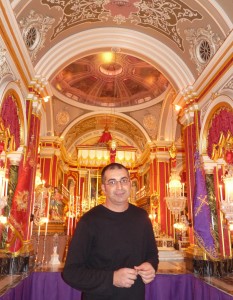 “After 26 years, I am proud to say that now we have our own premises at 37 East Street, Valletta. Although it is a small place, our 400 members meet keenly under its humble roof in order to attend to the regular activities that we organize. Members’ ages differ greatly; starting from young children of 7 and going up to elderly individuals over 90. Everybody is welcome in our group and together we learn and discuss new ideas of how to enrich this cultural tradition. Each of the members has the opportunity to explore his skills and to enhance them further both through the interaction with other members and also under the guidance of craftsmen and historians who are frequently invited to our premises. Many members have built their own church models, some of which one can even walk through – a popular model is that of Simon Mercieca which is often open to the public for viewing. Others have opted to produce statues and accessories which are used in the church models. Most of the members succeed in producing marvellous works, sometimes using common objects and transforming them into intricate decorations which adorne the models.”
“After 26 years, I am proud to say that now we have our own premises at 37 East Street, Valletta. Although it is a small place, our 400 members meet keenly under its humble roof in order to attend to the regular activities that we organize. Members’ ages differ greatly; starting from young children of 7 and going up to elderly individuals over 90. Everybody is welcome in our group and together we learn and discuss new ideas of how to enrich this cultural tradition. Each of the members has the opportunity to explore his skills and to enhance them further both through the interaction with other members and also under the guidance of craftsmen and historians who are frequently invited to our premises. Many members have built their own church models, some of which one can even walk through – a popular model is that of Simon Mercieca which is often open to the public for viewing. Others have opted to produce statues and accessories which are used in the church models. Most of the members succeed in producing marvellous works, sometimes using common objects and transforming them into intricate decorations which adorne the models.”Each year, during the Lenten period, the association organizes an exhibition with some of the works of the members, both to give them the opportunity to share their skill with others and also to attract the public to this old tradition.
“Our association is deeply cherished by its members. In fact some of them have honoured us by donating us prestigious works which belonged to them or to their families. It is a great privilege to possess a number of the few lucky survivors of war which managed to make it, as their owners lovingly took them along with them to safer areas.”
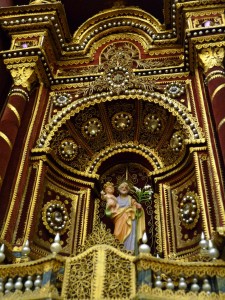 Raphael showed me some of these examples, including an elegant limestone church facade which was designed by Manuel Psaila between 1935 and 1940, and a delicate niche produced out of quilling which dates back to more than 100 years. I was thankful to Raphael for having shared with me this experience. His calm and serene smile was full of pride as his dream of giving the life back to a part of our culture was fulfilled. In fact the association’s work has succeeded to reach much further grounds than any of the members could ever have aspired for, when in 1994, Joseph Sciberras ended up winning a place in the Guinness Book of Records for his church model which was made out of more than 3 million used up matchsticks!
Raphael showed me some of these examples, including an elegant limestone church facade which was designed by Manuel Psaila between 1935 and 1940, and a delicate niche produced out of quilling which dates back to more than 100 years. I was thankful to Raphael for having shared with me this experience. His calm and serene smile was full of pride as his dream of giving the life back to a part of our culture was fulfilled. In fact the association’s work has succeeded to reach much further grounds than any of the members could ever have aspired for, when in 1994, Joseph Sciberras ended up winning a place in the Guinness Book of Records for his church model which was made out of more than 3 million used up matchsticks!I met Joseph Sciberras, now 93, in his son’s home in Attard. Sitting cosily near his bird pet who sung cheerfully at his side, Joseph told me the story of his model which has given him so much satisfaction in his life.
“I was an electrician by trade but during the war I was engaged as a soldier. I remember vividly a particular day when I was at work in Delimara and came to know that Floriana, where I lived, had just been badly hit by bomb attacks. I was desperate to see whether my family was safe and whether our house was damaged, and my superior allowed me to leave. I walked right back to Floriana there and then, and luckily both my family and my house were safe. The enemy used to target his attacks from the Floriana parish church and bomb throughout. We lived nearby and one day our house did fall victim to these attacks, alas like the church which did too anyway.
 Years passed and both our houses and the Floriana parish church were rebuilt. I used to like to observe the facade of our beloved church and when I became a pensioner, I decided to start building an exact model of it. I chose to construct it out of used up matchsticks. Day after day, I worked on my model, constantly taking measures and designing the acute details of the facade.
Years passed and both our houses and the Floriana parish church were rebuilt. I used to like to observe the facade of our beloved church and when I became a pensioner, I decided to start building an exact model of it. I chose to construct it out of used up matchsticks. Day after day, I worked on my model, constantly taking measures and designing the acute details of the facade.When my friends who most of them worked at the Dockyards got to know what I was doing, they started to collect used mathsticks for me. Then when I exhibited my first model to the public, these matchsticks began to arrive from different areas of Malta! I had so many in hand that I ended up doing all the parish church inside out, until eventually the model measured 2 metres by 2 metres with a height of a further 1.5 metres.
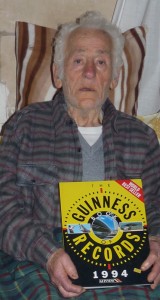 People were totally mesmerized by my model and many, including several tourists, even hugged me when they noticed all the details and work that I had put into my work. It was during one of these exhibitions when some foreigners entered to view my model. I could not be more lucky as these were officials of the Guinness Book of Records and as they studied and measured my model, they informed me that I had succeeded to break the record of the previous winner matchstick model! Soon a certificate arrived together with my inclusion in the Guinness Book of Records.” Spiritedly Joseph showed me his model church displayed on the pages of this famous book. He felt very satisfied that his hard work which took so many years to do was given such an acknowledgement.
People were totally mesmerized by my model and many, including several tourists, even hugged me when they noticed all the details and work that I had put into my work. It was during one of these exhibitions when some foreigners entered to view my model. I could not be more lucky as these were officials of the Guinness Book of Records and as they studied and measured my model, they informed me that I had succeeded to break the record of the previous winner matchstick model! Soon a certificate arrived together with my inclusion in the Guinness Book of Records.” Spiritedly Joseph showed me his model church displayed on the pages of this famous book. He felt very satisfied that his hard work which took so many years to do was given such an acknowledgement.“Ultimately this model became part of my life as I have dedicated much of my love and my time to it. In return it gave me happinness as I saw people admiring it and appreciating my skill and patience. I have taken good care of it all along these years and my final wish is to donate my model to our National Museum of Etnography wherein it could be enjoyed by the public in reminiscence of me and of this ancient cultural tradition. I feel sad to leave it behind me but one cannot live forever, can he?”
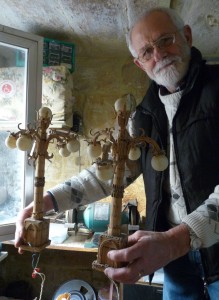 I could not resist the invitation of Francis, Joseph’s son, to visit the workshop of his father in Floriana wherein this model was stored. Humorously Francis indicated the name of the place “Sulfarina” (matchstick). “Interestingly our family was originally known as “Taċ-Ċomb” (of lead) but today, because of my father’s model, everyone knows us as “Tas-Sulfarini” (of the matchsticks). Notwithstanding that my father has stopped working now, I still find packets full of used matchsticks which people leave behind his door.”
I could not resist the invitation of Francis, Joseph’s son, to visit the workshop of his father in Floriana wherein this model was stored. Humorously Francis indicated the name of the place “Sulfarina” (matchstick). “Interestingly our family was originally known as “Taċ-Ċomb” (of lead) but today, because of my father’s model, everyone knows us as “Tas-Sulfarini” (of the matchsticks). Notwithstanding that my father has stopped working now, I still find packets full of used matchsticks which people leave behind his door.”We went into the small building which was totally engulfed by the huge model of the Floriana parish church and by other of Joseph’s works, all made of matchsticks. With some difficulty, Francis managed to find his way through the multitude of wires which his father had included in the model in order to light up the church.
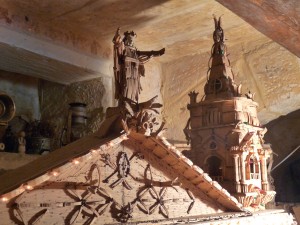 Now I could observe what Joseph had talked about…. the millions of matchsticks, each one placed or thwarted to fit into the shape that he had designed for them…. the facade, the dome, the walls, the columns, the niches, the floor, the minute chairs. There were also small silver apostles which Francis had made for his father to place on the altar. Miniature gorgeous chandeliers made up of common scrap hung beautifully along the flowing arches. It was all set up and ready as if inviting people to go inside.
Now I could observe what Joseph had talked about…. the millions of matchsticks, each one placed or thwarted to fit into the shape that he had designed for them…. the facade, the dome, the walls, the columns, the niches, the floor, the minute chairs. There were also small silver apostles which Francis had made for his father to place on the altar. Miniature gorgeous chandeliers made up of common scrap hung beautifully along the flowing arches. It was all set up and ready as if inviting people to go inside.I gazed inside the model church, my eyes resting and enjoying every detail whilst I slowly understood what this all means… Within this modest model lied the admirable representation of our local skills together with the ability of our people to prevail even through the hardest times.
For further information about the Għaqda Dilettanti Mudelli ta’ Knejjes, one can access their website www.freewebs.com/ghaqda_dilettanti_knejjes or join their facebook page.
(Note: An edited version of this article was published in FIRST magazine Issue April 2012. A pdf version of the published article is available on this website under the title MINIATURE CHURCH DEVOTION).
Travelogue
Archives
| M | T | W | T | F | S | S |
|---|---|---|---|---|---|---|
| « Jan | ||||||
| 1 | 2 | 3 | 4 | 5 | 6 | 7 |
| 8 | 9 | 10 | 11 | 12 | 13 | 14 |
| 15 | 16 | 17 | 18 | 19 | 20 | 21 |
| 22 | 23 | 24 | 25 | 26 | 27 | 28 |
| 29 | 30 | |||||
Recent Posts
- A MATTER OF FATE
- MALTA’S PREHISTORIC TREASURES
- THE MAGIC IS IN THE DETAIL
- THE SELLING GAME
- NEVER FORGOTTEN
- Ġrajjiet mhux mitmuma – 35 sena mit-Traġedja tal-Patrol Boat C23
- AN UNEXPECTED VISIT
- THE SISTERS OF THE CRIB
Comments
- Pauline Harkins on Novella – Li kieku stajt!
- admin on IL-KARNIVAL TRAĠIKU TAL-1823
- Albert on IL-KARNIVAL TRAĠIKU TAL-1823
- Martin Ratcliffe on Love in the time of war
- admin on 24 SENA ILU: IT-TRAĠEDJA TAL-PATROL BOAT C23